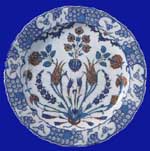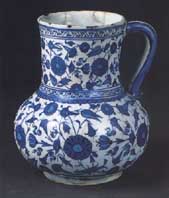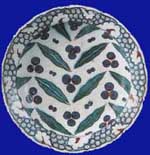|
Styles époques
ISLAMIC ART : IZNIK
|
Cet article se compose de 3 pages.
 1
2
3
1
2
3

|

«Tabak» plate with flowered fan-palms, circa 1570, 30 cm diametre (value : US $ 15,000) |

«Tabak» plate with Tulips, circa 1580, 31 cm diametre
(value US $ 30,000) |

Large «Tabak» plate with polychrome four-flower decor, circa 1570-75,
36.5 cm diametre
(Value : US $ 35,000) |
The first plates produced in Iznik between 1490 and 1525 had all a white and blue decor with Anatolian patterns. These pieces, with flowers and fan-palms were destined mainly to the Turkish court but lacked the quality of Chinese porcelains that were reserved for the use of the Sultan.
After ransacking Tebriz in 1514 Selim 1st brought back Yuan and Ming porcelains he had looted and Iznik artists soon found a new inspiration in copying these pieces before adding a personal touch to their productions. They thus mingled traditional Turkish elements, notably naturalistic patterns, with what they had copied from Chinese decors such as Yuan waves and rocks found on the edge of plates decorated with flowers.
Some grapes or ear corns from Ming pieces were often kept by Turkish potters but were adapted to become traditional Turkish elements such as the pattern reproducing Buddha's lips with a group of three balls placed like a pyramid.
Under the influence of painters from the Turkish court, potters reproduced flowers found in gardens such as tulips, which drove many Europeans mad at the start of the 17th Century, hyacinths, plum-trees and carnations. They thus produced plates with four flowers but their favourite theme was the tulip, queen of the Turkish gardens, the elongated form of which was well adapted on large plates. These potters even went as far as showing in their productions flowers that never existed.
|


|
Reminiscent of the blue and white pieces from China and the porcelains of the Medicis, Iznik ceramic pieces almost resembled porcelains thanks to their translucid glazing.
Iznik pieces with their Arabesque and flower decors expressed the enchantment of Turkey after Soliman the Magnificent had set up a manufacture in 1525 the town of Iznik, formerly Nicaea, which had been the Byzantine capital.
Ceramic pieces were already produced in Iznik at the end of the 15th Century and potters had already mastered techniques to produce large plates with the use of a siliceous paste containing a small proportion of clay that enabled them to create works which looked like porcelains.


«Tabak» plate with flowered fan-palms, circa 1570, 30 cm diametre (value : US $ 15,000) |

«Tabak» plate with Tulips, circa 1580, 31 cm diametre
(value US $ 30,000) |

Large «Tabak» plate with polychrome four-flower decor, circa 1570-75,
36.5 cm diametre
(Value : US $ 35,000) |
The first plates produced in Iznik between 1490 and 1525 had all a white and blue decor with Anatolian patterns. These pieces, with flowers and fan-palms were destined mainly to the Turkish court but lacked the quality of Chinese porcelains that were reserved for the use of the Sultan.
After ransacking Tebriz in 1514 Selim 1st brought back Yuan and Ming porcelains he had looted and Iznik artists soon found a new inspiration in copying these pieces before adding a personal touch to their productions. They thus mingled traditional Turkish elements, notably naturalistic patterns, with what they had copied from Chinese decors such as Yuan waves and rocks found on the edge of plates decorated with flowers.
Some grapes or ear corns from Ming pieces were often kept by Turkish potters but were adapted to become traditional Turkish elements such as the pattern reproducing Buddha's lips with a group of three balls placed like a pyramid.
Under the influence of painters from the Turkish court, potters reproduced flowers found in gardens such as tulips, which drove many Europeans mad at the start of the 17th Century, hyacinths, plum-trees and carnations. They thus produced plates with four flowers but their favourite theme was the tulip, queen of the Turkish gardens, the elongated form of which was well adapted on large plates. These potters even went as far as showing in their productions flowers that never existed.

Rare «Bardak» jug with blue tulips,
carnations and dog-roses, 18.5 cm high,
9.3 cm diametre, circa 1535-1545
(Value : US $ 35,000)

Rare «Tabak» hollow plate with «Buddha lips»
decor and «Cintamani» pyramid balls,
circa 1585, 34.5 cm diametre
(Value : US $ 45,000)
Artists in Topkapi created the new «Saz» style with long indented incurvated leaves and almost broken stems. During the 1525-1555 period the Iznik manufacture enjoyed a golden age with the production of its best decors. From white and blue pieces, potters went on to use a larger palette with light green colours and pale mauves but the glory of Iznik was to be found in its «Rhodes red» employed between 1555 and 1560 together with an emerald green. However, after 1580 the quality of Iznik pieces progressively declined until the manufacture was closed in 1718. In the meantime Iznik-styled pieces were copied in the Caucasian region and in Syria during the 17th Century. .
|
|
|
|